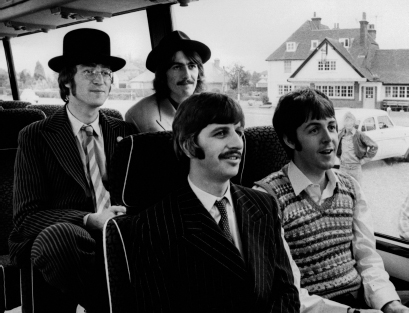![]()
ON THE SILVER SCREEN
MAGICAL MYSTERY TOUR
The Beatles’ Magical Mystery Tour is superb, brilliant, great, heavy, boss, light entertainment, good clean fun, a Message Picture, an entertaining nightmare, and it has good rock and roll music. It is by far the best of the Beatle films. It is not what you expect it to be at all.
– Tom Nolan, Los Angeles Free Press
When the show was screened by the BBC on December 26, the switchboard at the TV company’s London headquarters was jammed with calls from baffled viewers who didn’t understand what Magical Mystery Tour was all about.
– Tony Barrow, KRLA Beat magazine
Four days after Epstein’s death, The Beatles met in Paul’s house in St John’s Wood to discuss what they would do next. They had vetoed Robert Stigwood becoming their manager, but decided to stay with NEMS under the silent care of Epstein’s brother, Clive. They also decided to crack on with filming their television film, Magical Mystery Tour, now that they had six soundtrack songs recorded.
Before he died, Epstein had been positive about the project, going over Paul’s script – famously a big circle on a piece of paper divided into scene sections like a pie chart – to make sure all the band members were equally represented and taking notes on pre-production issues. He’d also booked cinematographer Peter Theobald, but otherwise the production was completely in the hands of The Beatles.
Armed with their pie chart and a copy of Spotlight, the theatre trade magazine, The Beatles began casting the film: Jessie Robbins was to play Ringo’s aunt; Derek Royle, the courier Jolly Jimmy Johnson; and Mandy Weet was the glamorous tour hostess Wendy Winters. Paul was a fan of Ivor Cutler, so cast him as the bus conductor, Buster Bloodvessel, and John recruited variety star Nat Jackley.
On 11 September, the cast, some friends, a crew of four cameramen, a sound man and a technical adviser climbed aboard the bus at Allsop Place in London. Off they went on their merry way, travelling and filming in Devon, Cornwall and Somerset.

The Beatles on the bus for their Magical Mystery Tour. Alamy
It was a chaotic yet good-natured shoot. Paul took on most of the directing responsibilities but everyone chipped in with ideas, and some highlights came about by chance. The ‘Jessie’s Dream’ sequence of John as a waiter shovelling spaghetti on to Aunt Jess’s plate was added after John told Paul of a dream he’d had. Naively, The Beatles didn’t realise that you had to book studios in advance, but they did manage to film some scenes at RAF West Malling, including the impressive Busby Berkeley-inspired performance of ‘Your Mother Should Know’. Victor Spinetti, the Beatles favourite who starred in A Hard Day’s Night and Help!, reprised his role in Joan Littlewood’s stage musical Oh! What a Lovely War, the Bonzo Dog Doo-Dah Band did a star turn in the strip-show scene, and Paul even managed a trip to the south of France to film his ‘Fool On The Hill’ section.
The band’s naivety became evident in the editing suite where they discovered that, because they hadn’t used clapper boards, the sound in each of the musical numbers was out of sync. But, undaunted, sharing the editing duties with Roy Benson, they managed to shape ten hours of material into their fifty-three-minute film, ready for broadcast in the BBC’s prime Boxing Day evening slot.
The TV critics hated it. Magical Mystery Tour was slated as the first major failure of the Fab Four. Paul stoutly defended the film, pointing out that it hadn’t helped that it had been shown in black and white, and that ‘the Queen’s speech was hardly a gas’.